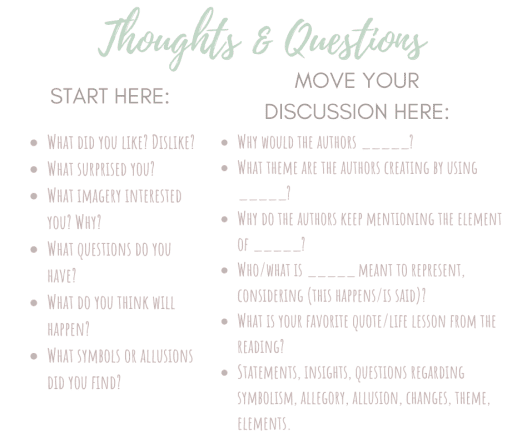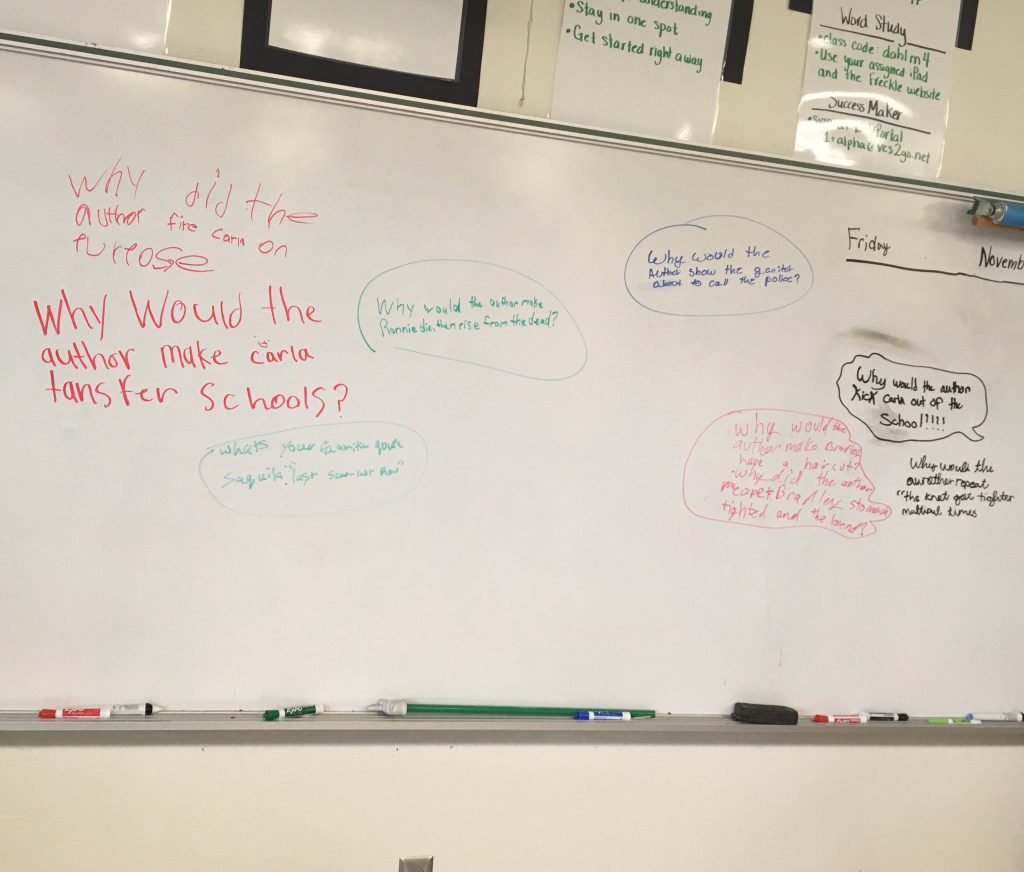When students are asked to craft their own thoughts, questions, and epiphanies (TQE), they are encouraged to think outside of the box; beyond what they may be comfortable doing on a regular basis. This past school year, I spent a lot of time focusing on improving the types of questions I ask my students. I hoped to ask stimulating questions that led to more meaningful book discussions. While researching the best practices for this, I came across the TQE Method. (TQE stands for Thoughts, Questions, and Epiphanies.) I knew I had found something that would challenge them and give them ownership in their learning; something that would help them to envision the story and make it come alive.
Before the TQE Method
Prior to using this technique, I would plan and prepare great questions to ask my students using Bloom’s Taxonomy. I felt that I would lead them to higher order thinking because my level of questioning would increase throughout our discussion, then they would respond more thoughtfully. Many students often shared great answers and showed an understanding of the story.
If you are aren’t a teacher in the classroom, you might find this confusing. Maybe you would like to ask your child questions while they read, but you have a hard time getting past, “What did you just read?” or “What was your favorite part?”
Often times, this leads to kids who are unable to make connections with the text. In the classroom, only one or two students would raise their hands and the others would try to go unnoticed. They may not be invested in the story. Also, I was the one doing all of the work in order to prepare for these discussions.
After the TQE Method
When I changed up my strategy, I found that teaching them how to ask questions caused them to think more deeply about the text. Stories became magical and meaningful! It also encouraged them to compare what we’re reading to other books and passages, and they were more likely to look at the themes of the story in light of themselves. Their application to the text was much more profound!
By the end of our time in the classroom, I also found that the students listened to their peers more carefully and they were able to critically respond to others’ ideas. This is the ideal way to teach to the whole child.
Cult of Pedagogy & More Meaningful Book Discussions
I originally heard about this method to lead more meaningful book discussions while listening to The Cult of Pedagogy‘s podcast (Episode 103). In the interview, she spoke to a high school English teacher who used this method with her students. I would highly recommend that you listen to it for further insight.
You might be wondering why I took a strategy intended for high school students and used it with my ten and eleven year olds. That’s a good question!
I figured that this could easily be differentiated based on the level of questions that are presented. And, since the students are presenting their ideas, they would automatically differentiate it to their own level. Perfect! I had to give it a try.
Here’s how to lead more meaningful book discussions…
- I always have a read aloud that we use for discussion in class. This can work with ANY book.
- Each day my students and I would read a few chapters from our novel.
- After reading, they would find a partner.
- On the board I put up a graphic with lead questions. These came directly from the Cult of Pedagogy podcast that I mentioned previously.
5. I set a timer for 3-5 minutes and tell them to discuss the questions on the left side of the graphic titled “Start Here.”
6. Once the timer goes off, I would reset it adding on a couple of minutes. This time they would discuss the questions on the right side of the graphic titled, “Move Your Discussion Here.”
These questions are more in depth and require more attention. Sometimes they struggle to move past the first one, but with practice they eventually get there. It’s important to periodically take time to model example questions if you notice that your students get hung up on one type of question.
Also, to encourage a genuine discussion, I have them use the author’s name instead of just saying “the author.” I feel it brings the literary process to life and makes it more realistic.
While students are discussing, I move around the room to listen in on their chats. I try not to add anything to their conversation because there will be time for that later.
7. A minute or two before the timer goes off, I give each pair an index card. They write down one important idea from their discussion: a novel thought, question, or an epiphany.
8. At this point, I would look at their writing and then have them post it on the board for everyone to see.
9. As a class, we discuss each of these ideas. I have the person who wrote the question read it aloud, explain their initial thoughts and then other students respond; they add to the original discussion.
This simple act, discussing questions and thoughts that the students came up with makes the conversation much more authentic and inevitably leads to more meaningful book discussions. There are many more students who are eager to add to the conversation as opposed to the times when I come up with questions. My favorite part of this activity is that the students OFTEN come up with ideas that I had not thought about it. These fantastic ten year olds never cease to amaze me!
Another fantastic way to help students to become more engaged in reading is to share book series with them. Be sure to check out the 7 Reasons to Read Books in a Series to help your child find a series that is a good fit for them!





